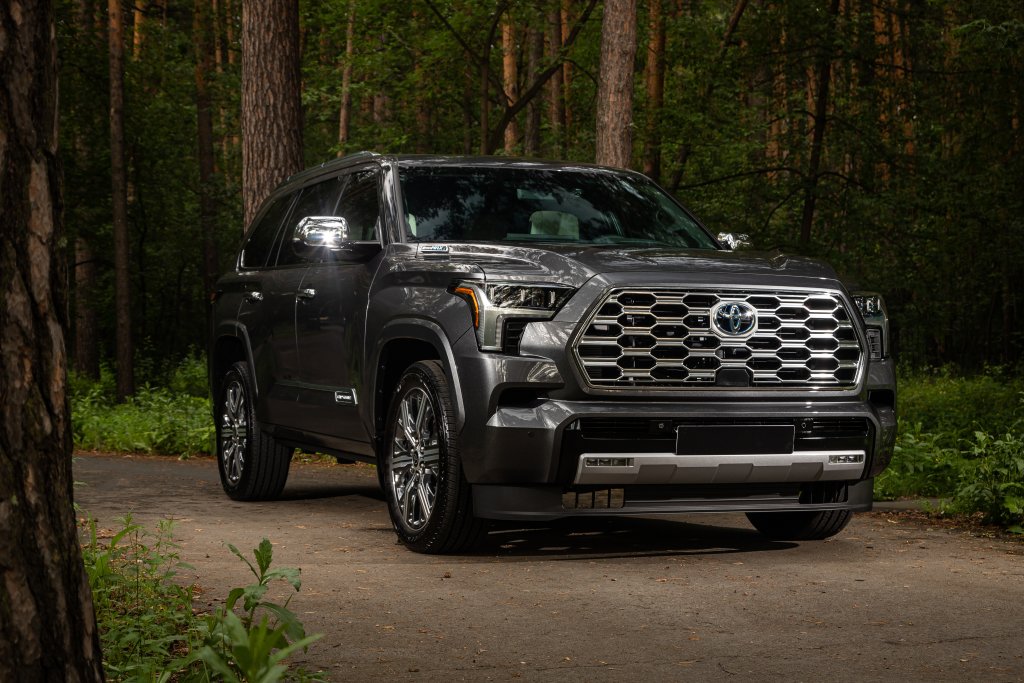The Toyota Sequoia is a full-size SUV that has been on the road since its 2001 model year. It’s based on the Toyota Tundra pickup and is the second-largest SUV ever made by the automaker. Through 2021, it sat between the smaller Toyota 4Runner and the Toyota Land Cruiser. With the discontinuation of the Land Cruiser, it is now the largest in the lineup. More than 500,000 Sequoias have been sold since its introduction, but the past few years have been among some of the worst in its history.
Before picking out which large SUV model year belongs at your home, we advise you to do some research. Some models have lower reliability than others, leaving you with expensive repair bills. We help make the selection easier by giving you access to our data. This information helps you quickly determine which Sequoia models are worth putting your family in.
Pay close attention to the data coming directly from the FIXD car scanners owners have relied on for their Toyota Sequoia SUVs. We combine this information with other top sources to ensure you get a clear picture of all of the models.
|
Best Years |
Why? |
|
High-reliability scores, superior resale values |
|
|
Good reliability scores, lower cost of ownership |
|
|
Average reliability scores, super low cost of ownership average |
|
|
First model in 2nd generation exceeds expectations |
|
|
High FIXD reliability score, average ownership costs |
|
Worst Years |
Why? |
|
Low FIXD reliability scores, excessive annual maintenance costs |
|
|
Average cost of maintenance with lower resale values and higher mileage |
|
|
Early models of the 2nd generation have average reliability scores and ownership costs |
|
|
While the F.I.R.I.S. ratings show higher, the maintenance costs start to creep up slightly |
Toyota Sequoia Engine Reliability Score, Safety Ratings, MPG, Value v.s. Maintenance & Repair Cost, and F.I.R.I.S. – Year by Year
You could invest a lot of time into finding the right Toyota Sequoia model that has everything you want, or you can look at our handy charts to get a better idea quickly. Our data makes it easier to determine which models are reliable and worth your money. We include ratings from the top automotive publications, along with fuel economy scores, safety rankings, annual maintenance costs, and reliability scores.
Before settling for the Toyota Sequoia, check out a few other large SUVs. We have rankings for the Ford Expedition, Chevrolet Suburban, and GMC Yukon.
If you’re in the market for a car, take a look at our article on the USA’s most reliable and cheapest to repair cars in the U.S. Don’t get stuck with a lemon, use our data to help you shop.
Engine Reliability Score – Over The Years
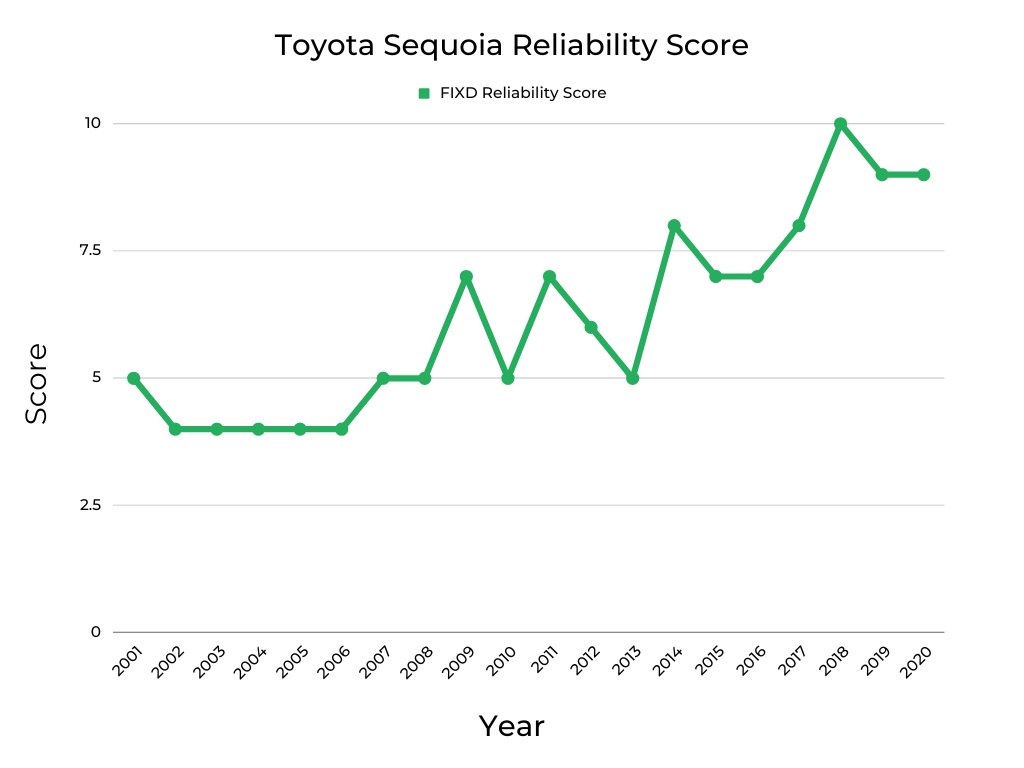
The Toyota Sequoia reliability chart above shows how each model year performs. We use the number of check engine lights set by the Sequoia models, weighted by an average of 12,000 miles of driving per year.
All of the scores fall between 1 and 10. The best score is 10, while the lowest is 1. Average scores sit around 5. Overall, the newer Sequoia model years earn the best FIXD reliability scores. Yet, this information must be weighed against the other data we have to determine the best and worst models.
Before moving on, make sure you check out Toyota Check Engine Light | Top 5 Causes for Each Model.
NHTSA Safety Score – Over The Years
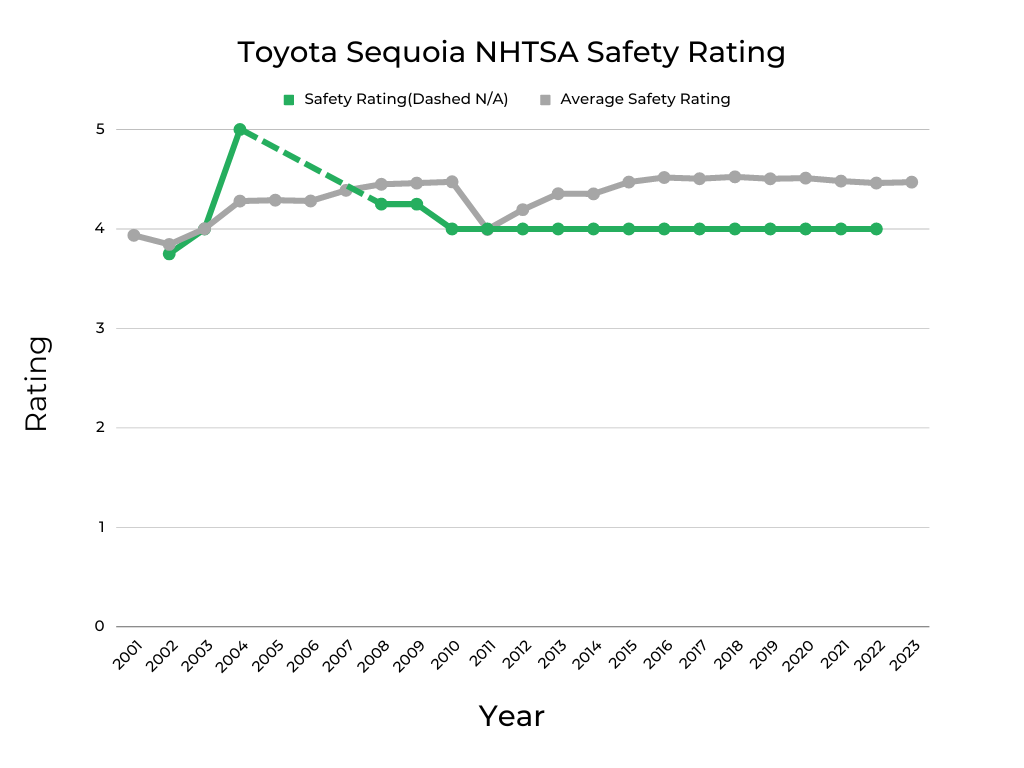
We relied on information from the National Highway Transportation Safety Administration (NHTSA) when determining if a vehicle is considered safe. This government agency performs crash tests on most modern vehicles and awards them with a score.
By looking at the chart, you see that the Toyota Sequoia tends to fall below average with other vehicles we’ve compiled data on. The green line reveals how well the Sequoia models performed compared with the gray line, which is the average. However, the average rankings also include smaller SUVs and cars that naturally tend to have better scores overall.
When it comes to driving your family around, you want a safe SUV. You also want one with good crash test ratings because it helps you score cheap car insurance rates. Expect the premiums to be slightly higher when the scores go this low.
If you live in one of the states listed below, we can show you the cheapest vehicles to insure in yours.
| What Used Cars Are the Cheapest To Insure In: |
| Ohio |
| North Carolina |
| Michigan |
| Georgia |
| Texas |
| New York |
| Illinois |
| Pennsylvania |
| California |
MPG – Over The Years
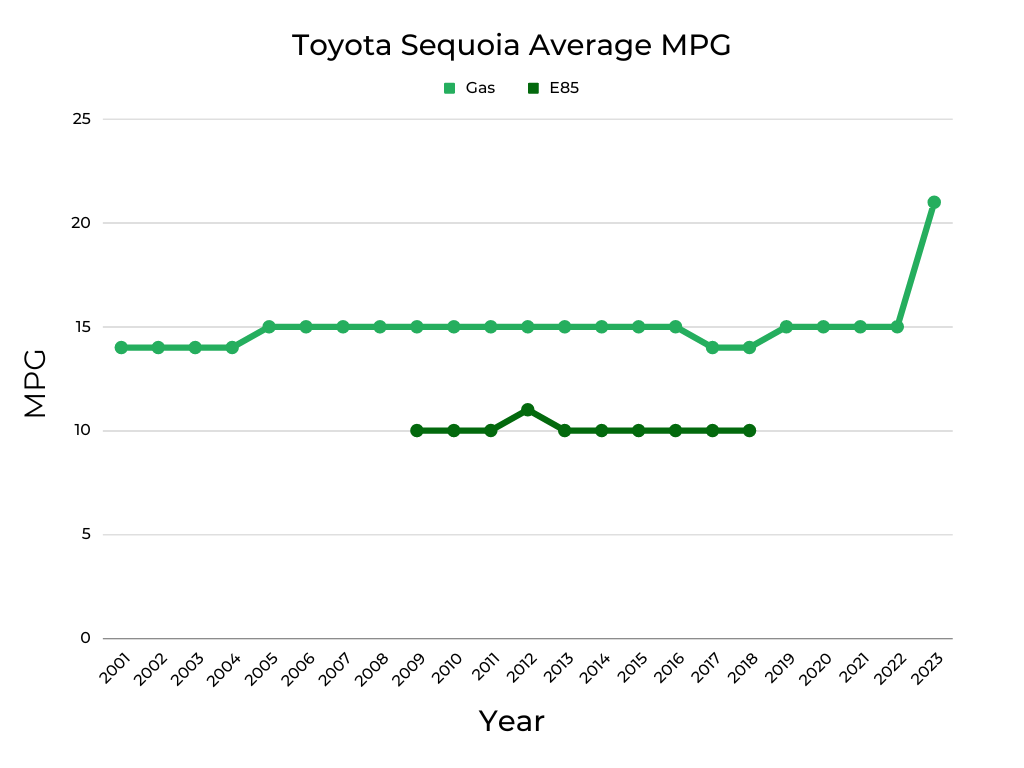
Toyota Sequoia SUVs have plenty of passenger and cargo space, so they aren’t designed to be fuel-efficient. For the majority of the models, the fuel economy ratings remain nearly the same. Gas-powered models (light-green line) tend to average between 14 and 15 mpg, while the E85 models (dark green line) tend to average between 10 and 11 mpg. Our scores are pulled from fueleconomy.gov, with an average across all trim levels and configurations.
Current Market Value of All Toyota Sequoia Years vs. Value for the Money

Some Toyota Sequoia SUVs can now be purchased for less than $10,000 because of their age. However, as the SUV racks up more mileage on the odometer and it gets older, it also tends to need more maintenance. That’s why you must also factor in the average cost of ownership, which we sourced from repairpal.com. Before you buy or sell a Sequoia, we also recommend running a personalized KBB value report that uses the model year, mileage, trim level, and features.
When shopping for a used Toyota Sequoia, it’s important to keep in mind that not all vehicles are cared for equally. To protect yourself from lemons, take along a FIXD Sensor on your test drive. FIXD connects to a free app on your smartphone to tell you more about the vehicle you’re checking out, including check engine lights and other hidden issues that the owner or dealership may be attempting to hide. Click here to learn more and get FIXD for only $19.99 (regular price $59)!
F.I.R.I.S. – Fixd Internet Review Index Score– Over the Model Years
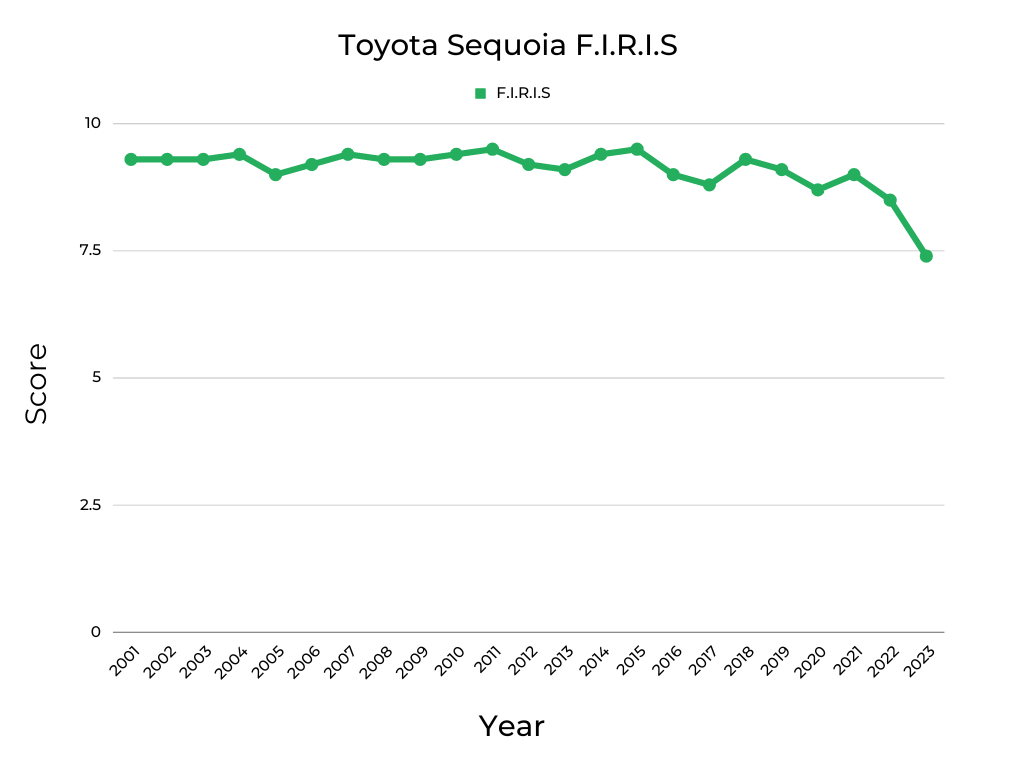
The Fixd Internet Review Index Score (F.I.R.I.S.) takes into account several different factors. We average the ratings from these sites to determine the overall average score:
As you can see, none of the Toyota Sequoia models we reviewed received a terrible rating that would stick out as a bad year. There are some minor dips throughout the ratings, but nothing to be overly concerned with.
Important Features Timeline
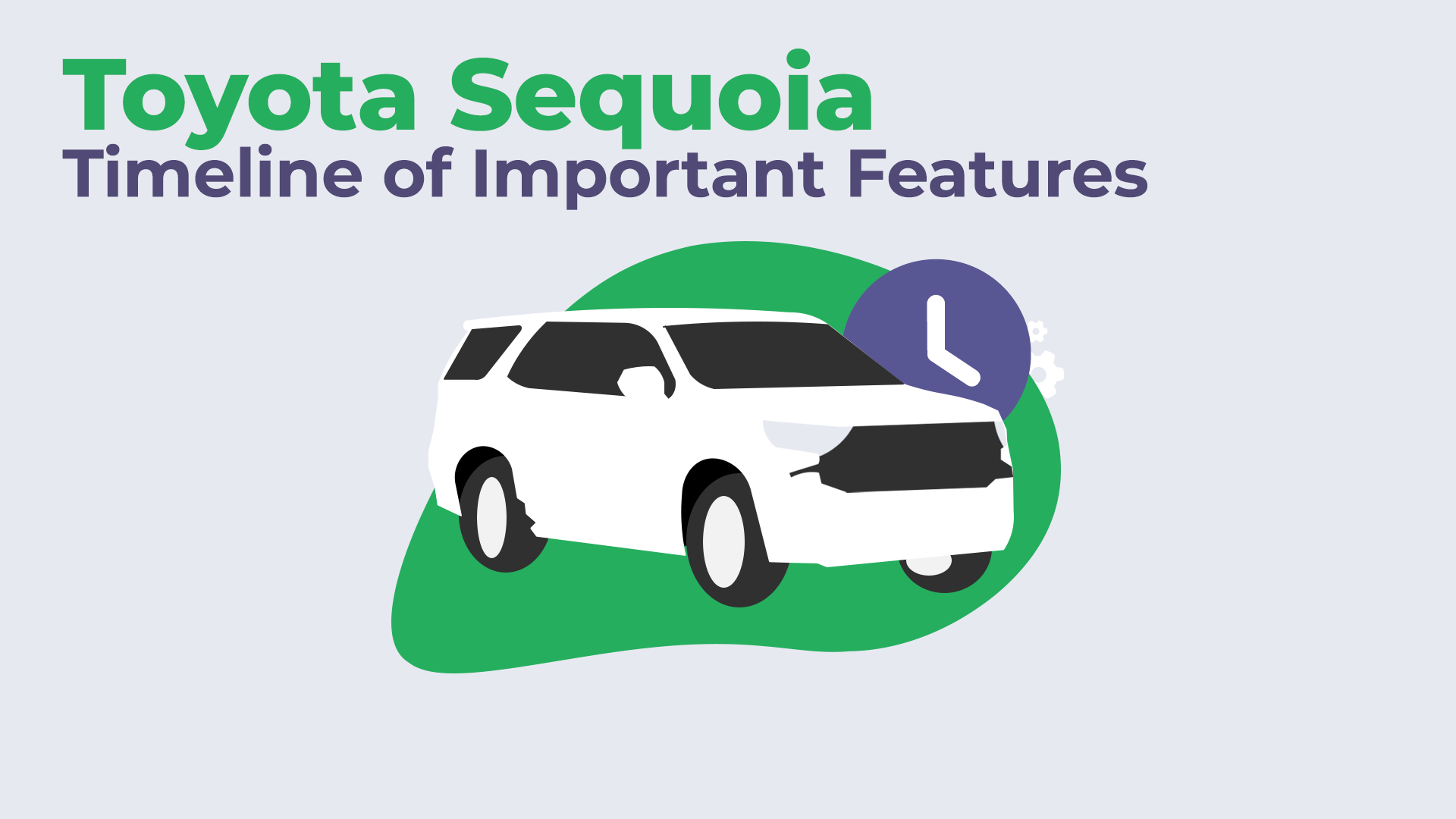
2001: Brand-new full-size SUV model released based on the Tundra pickup
2002: Remains mostly unchanged
2003: New 17” alloy wheels and tires added, Limited trim receives standard auto-dimming mirror, newly available rear DVD entertainment system with cordless headphones added, optional load-leveling rear suspension debuts
2004: SR5 trim includes rear air conditioner and power front seats, Limited trim comes with a sunroof
2005: 4.7L V8 horsepower increased to 282, redesigned SUV includes new grille and front fascia, SR5 includes new sport package with fog lamps, a height-adjustable rear suspension, JBL premium sound system, 16” alloy wheels, and a front skid plate, Limited Luxury package comes with second-row leather buckets seats, wood trim, a height-adjustable rear suspension, driver seat memory feature, and a removable center console
2006: Remains mostly unchanged
2007: Standard front-seat side airbags and side curtain airbags debut, SR5 models receive a body-color grille, and Limited models include chrome mirrors
2008: Completely redesigned for 2nd generation with a more powerful 5.7L V8 engine and fold-flat third-row seat, new Platinum trim adds luxury features from the Lexus lineup.
2009: The new available sport package (SX) includes 20” wheels, fog lights, a rear spoiler, and a color-keyed grille, E85 ethanol flex-fuel configuration becomes available
2010: Base V8 engine becomes more powerful, standard front-seat knee airbags added, base stereo includes iPod integration and Bluetooth
2011: Remains mostly unchanged
2012: Standard trailer sway control added, Platinum models come with a blind-spot warning system
2013: Smaller V8 engine no longer available, optional Blu-ray rear-seat entertainment system added to the lineup
2014: Standard Entune infotainment system added
2015: Sunroof and a rearview camera added as standard equipment
2016: Limited trim includes optional blind spot monitoring system
2017: Remains mostly unchanged
2018: New TRD Sport trim released, all models include LED headlights, forward collision warning, automatic emergency braking and other standard safety features, grille and gauge cluster restyled
2019: Remains mostly unchanged
2020: TRD Pro trim level introduced, new suspension adds off-road capability, standard features include a 7” touchscreen with Apple CarPlay and Android Auto
2021: Optional Nightshade package offered with blacked-out exterior trim
2022: Remains mostly unchanged
The Best Years of the Toyota Sequoia
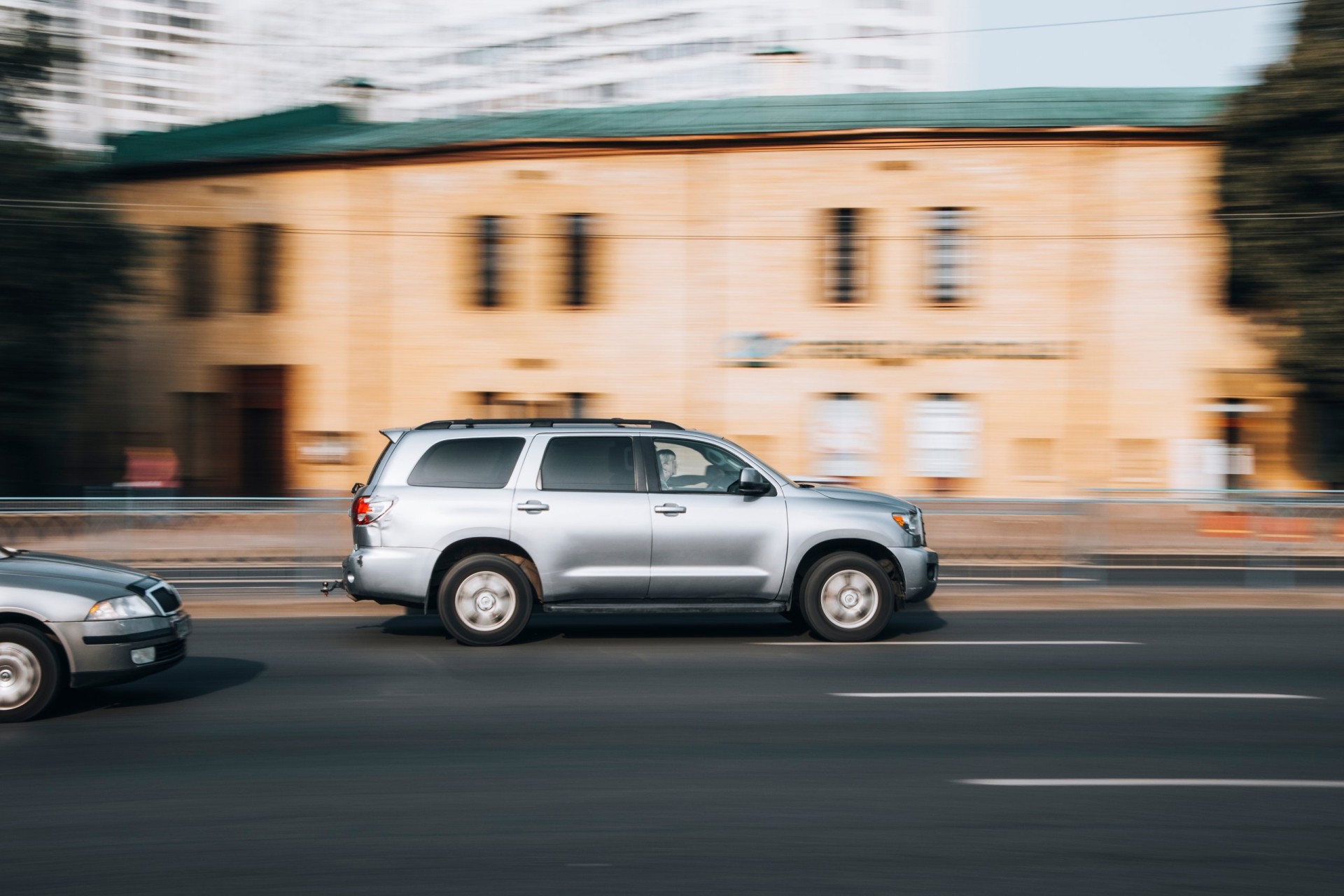
To get the overall rating of each Toyota Sequoia model, we had to combine the FIXD Reliability ratings with other data we’ve collected. You will see the ranking of best to worst Toyota Sequoia models based on the combined scores that include average maintenance costs, safety ratings, fuel economy scores, common trouble codes, and recalls, as provided by the National Highway Traffic Safety Administration (NHTSA).
2019-2020 Toyota Sequoia
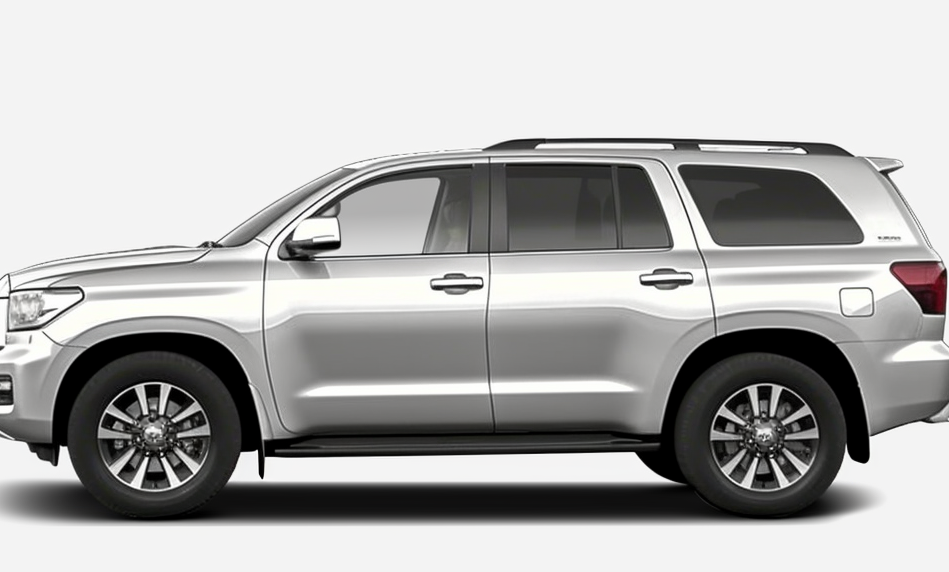
FIXD Reliability Score: 9/10
FIXD Internet Review Index Score (F.I.R.I.S): 8.7-9.1/10
Mileage Est. KBB Value: $35,112-$40,502
Fuel Economy: 15 mpg (gas)
RepairPal Average Annual Repairs Total: N/A
Safety Rating: 4.0/5
The 2019 and 2020 Toyota Sequoia are among the newest models we’ve reviewed and are rated as some of the best. Not only can you expect to pay less on repairs for these SUVs because of the warranty, but they have a high resale value, allowing you to get your money’s worth out of them.
The FIXD Reliability score for both the 2019 and 2020 Sequoia is 9 out of 10. Additionally, our F.I.R.I.S. on the 2019 Sequoia is 9.1/10, while the 2020 Sequoia is rated at 8.7/10.
The NHTSA crash test scores for the 2019 and 2020 Toyota Sequoia are both 4.0 (out of 5). Sadly, this is below average among all vehicles we’ve charted, but may not be too far off from other large SUVs.
These two Sequoia models are only available with a standard gas-powered engine. The average fuel economy across the board is 15 mpg.
We don’t have annual repair estimates on these two models, but there is still probably some warranty coverage for owners. Toyota provides a 3-year/36,000-mile limited warranty and a 5-year/60,000-mile powertrain warranty on new vehicles. Some repairs may still fall under this protection, thereby reducing unexpected costs.
The 2019 Toyota Sequoia tends to suffer from the Startability Malfunction (P1604) code and the TCU Communication Error (P1603) DTC. In some cases, these two trouble codes are related. With the 2020 Toyota Sequoia, the most common error is the Random, Multiple Misfire Detected (P0300) code. There’s also the chance for the Evaporative Emission Control System Incorrect Purge Flow Issue (P0441) code or the Catalyst System Efficiency Below Threshold Bank 2 (P0430) DTC.
The 2019 Toyota Sequoia has six recalls, but the 2020 Toyota Sequoia only shows two.
2015-2018 Toyota Sequoia

FIXD Reliability Score: 7-10/10
FIXD Internet Review Index Score (F.I.R.I.S): 8.8-9.5/10
Mileage Est. KBB Value: $21,597-$34,381
Fuel Economy: 14-15 mpg (gas), 10 mpg (E85)
RepairPal Average Annual Repairs Total: $564-$639
Safety Rating: 4.0/5
As part of the 2nd generation, these Toyota Sequoia models rank as some of the best. They have excellent reliability scores and shouldn’t cost a lot to maintain.
The FIXD Reliability score for both the 2015 and 2016 Sequoia is 7 out of 10, while the 2017 Toyota SUV earns 8 out of 10, and the 2018 Sequoia is ranked at a perfect 10 out of 10. Additionally, our F.I.R.I.S. on the 2015 Sequoia is 9.5/10, while the 2016 Sequoia is rated at 9.0/10. The 2017 Sequoia earns 8.8/10, and the 2018 model year has a score of 9.3/10.
The NHTSA crash test scores for these four Toyota Sequoia models remain at 4.0 (out of 5). Again, this rating does fall short, so it’s something to consider when evaluating what large SUV to buy.
These four Sequoia models have both conventional gas and flex-fuel engine configurations. All of the flex-fuel (E85) models average 10 mpg. The conventional gas for the 2015 and 2016 Sequoia earns 15 mpg. Unfortunately, some changes were made to the 2017 and 2018 models, reducing the average scores to 14 mpg.
As far as maintenance costs go, you can’t ask for much better than these Sequoia models. While we don’t have estimates on the 2018 Sequoia, we can tell you the others are impressive. The lowest average is with the 2017 Toyota Sequoia ($564). However, the other two models, the 2015 Sequoia and 2016 Sequoia, both fare well, averaging $639 and $569, respectively.
The most common trouble code with all four models is the Startability Malfunction (P1604) DTC. In some models, a new mass air flow sensor was installed to fix the problem, costing $172 to $309. The 2016 Toyota Sequoia also deals with the Engine Rough Idling (P1605) code, which could be related to the previous issue. Aside from that, you need to look out for the Evaporative Emission Control System Incorrect Purge Flow Issue (P0441) code with the 2017 and 2018 Toyota Sequoia models.
The 2015 Toyota Sequoia has three recalls, while the 2016 Toyota Sequoia shows the same. With the 2017 Toyota Sequoia showing three recalls, the 2018 Toyota Sequoia is dealing with five.
2007 Toyota Sequoia
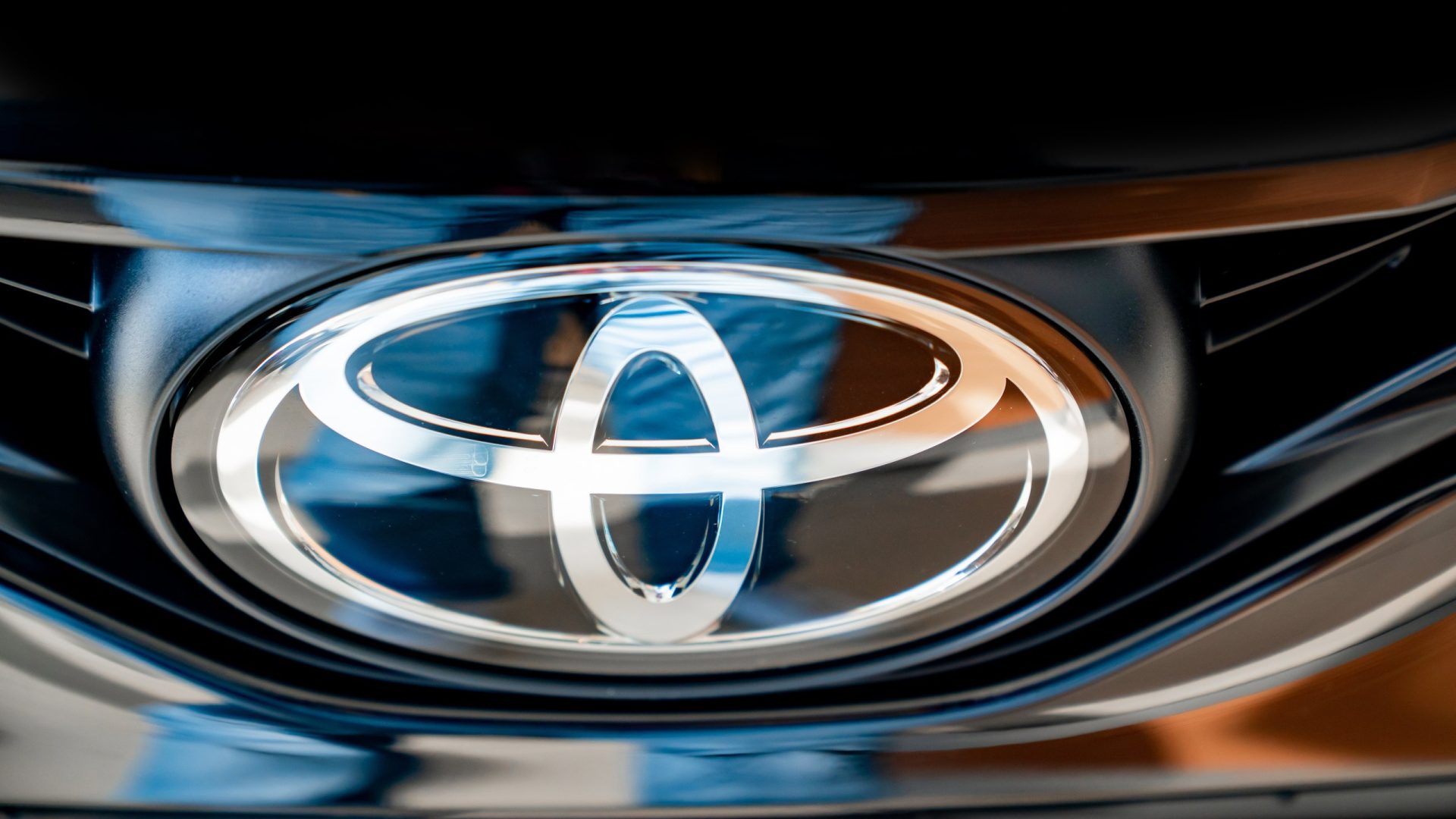
FIXD Reliability Score: 5/10
FIXD Internet Review Index Score (F.I.R.I.S): 9.4/10
Mileage Est. KBB Value: $6,469
Fuel Economy: 15 mpg (gas)
RepairPal Average Annual Repairs Total: $457
Safety Rating: N/A
The final model of the 1st generation deserves a spot in our best Sequoia list because it’s affordable to own yet still reliable.
The FIXD Reliability score for the 2007 Toyota Sequoia is 5/10. Additionally, our F.I.R.I.S on the 2007 Sequoia is 9.4/10.
We don’t have the NHTSA crash test scores on the 2007 Toyota Sequoia, but we can trust that they wouldn’t be much better than any of the other models we’ve looked at.
This Sequoia SUV only has a conventional gas-powered engine. It earns 15 mpg on average.
Despite being an older model, maintenance costs are still relatively low. RepairPal estimates that this model may cost $457 a year, which is great if you are strapped for cash.
The top DTC with the 2007 Toyota Sequoia is the Secondary Air Injection System Pump Stuck Off Bank 1 (P2445) code. It also suffers from the Catalyst System Efficiency Below Threshold Bank 2 (P0430) DTC, which could lead to a bill of $1,538 to $2,041 if you need a new catalytic converter installed. You also have to look out for the Secondary Air Injection System Relay A circuit Malfunction (P0418) code, which can often be related to the first one we mentioned.
As far as recalls are concerned, the 2007 Toyota Sequoia does show nine.
2008 Toyota Sequoia

FIXD Reliability Score: 5/10
FIXD Internet Review Index Score (F.I.R.I.S): 9.3/10
Mileage Est. KBB Value: $8,374
Fuel Economy: 15 mpg (gas)
RepairPal Average Annual Repairs Total: $478
Safety Rating: 4.25/5
Typically, when an automaker sends out a brand-new generation, there are tons of complaints and problems, but that doesn’t seem to be the case with the 2008 Toyota Sequoia.
The FIXD Reliability score for the 2008 Toyota Sequoia is 5/10. Additionally, our F.I.R.I.S. on the 2008 Sequoia is just slightly lower than the last model at 9.3/10.
The NHTSA crash test rating of the 2008 Toyota Sequoia is 4.25 (out of 5). While this isn’t terrible, it doesn’t keep up with other vehicles we’ve tracked.
This Sequoia SUV only comes with conventional gas-powered engine options. It earns 15 mpg on average.
You will spend a little more on this model than on the previous one. However, RepairPal estimates that this model may cost $478 a year for maintenance, which is nothing to complain about.
With the 2008 Toyota Sequoia, the top trouble codes appear to be related. This model deals with the Secondary Air Injection System Pump Stuck off Bank 2 (P2447) code and the Secondary Air Injection System Switching Valve Stuck Closed Bank 2 (P2443) DTC. It’s also known for the common Secondary Air Injection System Pump Stuck Off Bank 1 (P2445) code.
As a new generation, we expect to see a lot more recalls as the automaker works things out. However, the 2008 Toyota Sequoia has nine recalls, the same as the model from the last generation.
2014 Toyota Sequoia

FIXD Reliability Score: 8/10
FIXD Internet Review Index Score (F.I.R.I.S): 9.4/10
Mileage Est. KBB Value: $19,190
Fuel Economy: 15 mpg (gas), 10 mpg (E85)
RepairPal Average Annual Repairs Total: $722
Safety Rating: 4.0/5
The 2014 Toyota Sequoia rounds out our list of best models because it continues to have good reliability ratings and doesn’t cost a lot to own.
The FIXD Reliability score for the 2014 Toyota Sequoia is 8/10. Additionally, our F.I.R.I.S. on the 2014 Sequoia is impressive at 9.4/10.
The NHTSA crash test rating of the 2014 Toyota Sequoia is 4.0 (out of 5). This is among the lowest and something to be slightly concerned with.
This Sequoia SUV comes with conventional gas-powered engine options that average 15 mpg. It also offers an E85 engine, rated for 10 mpg.
At $722 a year for maintenance, this Sequoia shouldn’t take your last penny. Plus, there’s plenty of room in its value for you to keep it for several years.
The 2014 Toyota Sequoia tends to suffer from the Startability Malfunction (P1604) code. It also shows a higher instance of the ABS Inlet Valve Coil LF Circuit Short to Ground (C1201) DTC and the System Too Lean Bank 2 (P0174) code. Because of the advanced nature of these trouble codes, you may need a mechanic to help you perform further diagnostics.
The 2014 Toyota Sequoia only shows three recalls.
The Worst Years of the Toyota Sequoia

Using the same data as above, we found the worst Toyota Sequoia models. These are ranked from the ones you should avoid to others that may not be quite as bad.
2001-2004 Toyota Sequoia
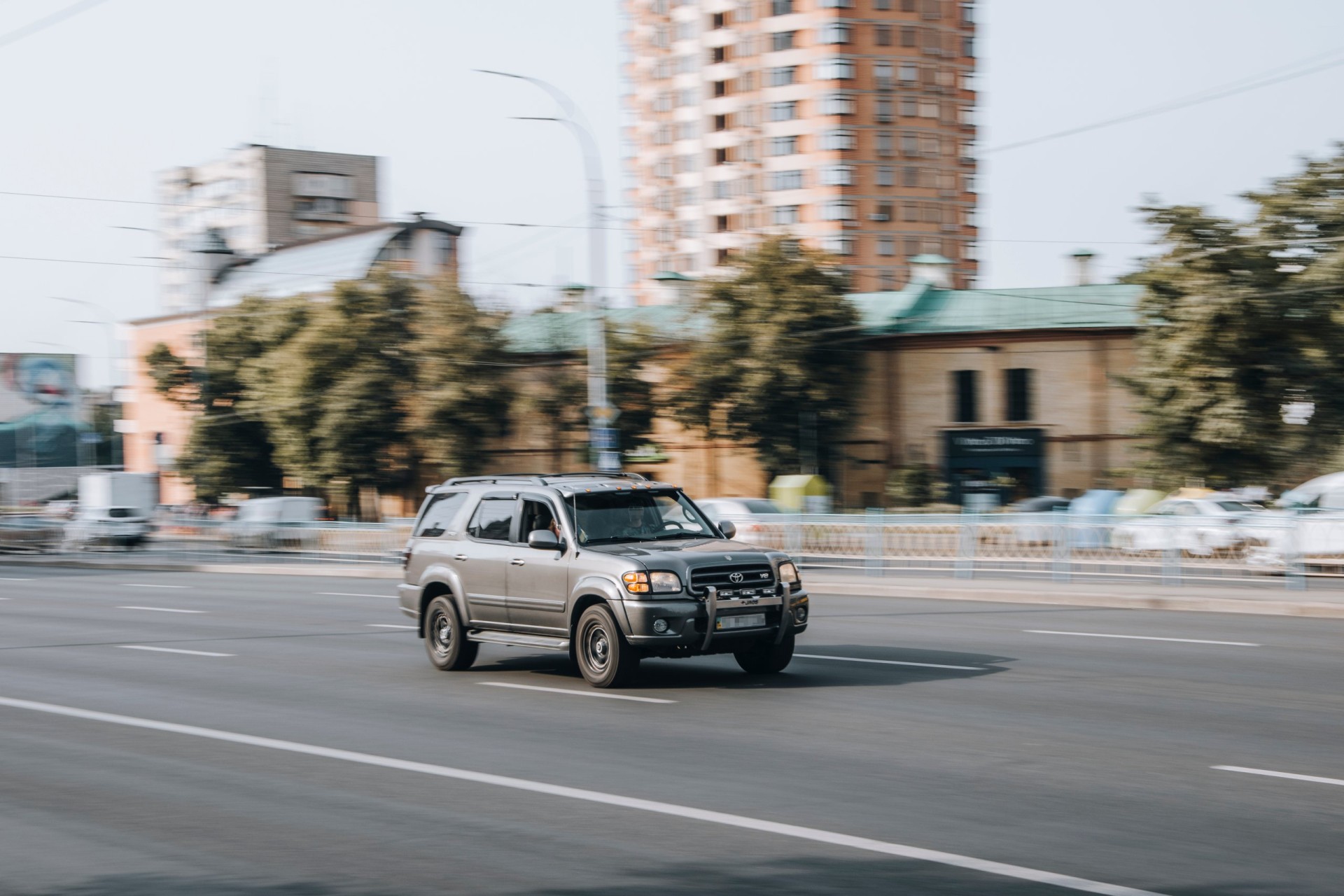
FIXD Reliability Score: 4-5/10
FIXD Internet Review Index Score (F.I.R.I.S): 9.3-9.4/10
Mileage Est. KBB Value: $3,573-$4,234
Fuel Economy: 14 mpg (gas)
RepairPal Average Annual Repairs Total: $500-$2,500
Safety Rating: 3.75-5/5
As the oldest models in our lineup, these needed to be put in last place. One major repair is going to send these Sequoias to the junkyard, and they are known for expensive problems.
The FIXD Reliability score for the 2001 Toyota Sequoia is 5/10, while the other three models rank at 4/10. Additionally, our F.I.R.I.S on the 2001, 2002, and 2003 Sequoia is impressive at 9.3/10, while the 2004 model earns 9.4/10.
We don’t have crash test ratings on the 2001 Toyota Sequoia, but the 2002 model earns 3.75 (out of 5), while the 2003 Sequoia averages 4 (out of 5). The only model that does well is the 2004 Toyota Sequoia, scoring a perfect 5 (out of 5).
These four Sequoia SUVs only offer a conventional gas-powered engine. It averages 14 mpg.
Ownership costs are the real problem with these models. At the lowest end, the 2003 Sequoia shows an average of $500 a year. Yet, you could spend $2,500 a year with your 2004 Sequoia. Either way, one major repair makes these SUVs not worth fixing, and we show plenty of expensive problems occurring.
The 2001, 2002, and 2003 Toyota Sequoia show a higher chance of the Catalyst System Efficiency Below Threshold (P0420) code. Additionally, the 2001 and 2003 models show the Catalyst System Efficiency Below Threshold Bank 2 (P0430) DTC. With either of these problems, you may need a new catalytic converter, costing $1,538 to $2,041. The 2001 and 2002 Toyota Sequoia models also struggle with the Evaporative Emission Control System Malfunction (P0440) code. Most closely related to this, the 2004 Sequoia also shows the Evaporative Emission Control System Incorrect Purge Flow (P0441) code, while the 2002 and 2004 models have the Evaporative Emission Control System Vent Control Circuit Malfunction (P0446) codes as one of the top problems. With all of these DTCs, the Sequoia may require a new charcoal canister, costing $753 to $1,000.
The 2001 Toyota Sequoia only has three recalls, but the 2002 Toyota Sequoia shows eight. 2003 Toyota Sequoia models have seven recalls and the 2004 Toyota Sequoia reveals nine.
2005-2006 Toyota Sequoia

FIXD Reliability Score: 4/10
FIXD Internet Review Index Score (F.I.R.I.S): 9.0-9.2/10
Mileage Est. KBB Value: $5,166-$5,560
Fuel Economy: 15 mpg (gas)
RepairPal Average Annual Repairs Total: $750
Safety Rating: N/A
The next models to avoid include the 2005 and 2006. Both of these have lower reliability scores and may cost too much to repair.
The FIXD Reliability score for the 2005 and 2006 Toyota Sequoia is 4/10. Additionally, our F.I.R.I.S. on the 2005 Toyota Sequoia is 9.0/10, while the 2006 Sequoia earns 9.2/10.
While there aren’t crash test ratings for the 2005 and 2006 Toyota Sequoia, we know that only one model of the ones we reviewed fared well. Therefore, it’s safe to assume that these may not be the safest large SUV option.
These two Sequoia SUVs only offer a conventional gas-powered engine. It averages 15 mpg, which is slightly better than the previous years we just reviewed.
Maintenance costs may not be a big deal at $750 a year. However, with the lower resale value, you still don’t have a lot of wiggle room for major repairs.
The biggest issue with both Sequoia models is the Secondary Air Injection System Pump Stuck Off Bank 1 (P2445) code. They both also deal with the Catalyst System Efficiency Below Threshold (P0420) code, which may require a new catalytic converter, costing $1,538 to $2,041. Additionally, the 2005 Sequoia also shows a higher instance of the Catalyst System Efficiency Below Threshold Bank 2 (P0430) DTC, also dealing with the catalytic converter.
What’s most alarming is how the 2005 Toyota Sequoia has 11 recalls, while the 2006 Toyota Sequoia shows ten.
2009-2010 Toyota Sequoia

FIXD Reliability Score: 5-7/10
FIXD Internet Review Index Score (F.I.R.I.S): 9.3-9.4/10
Mileage Est. KBB Value: $9,515-$10,065
Fuel Economy: 15 mpg (gas), 10 mpg (E85)
RepairPal Average Annual Repairs Total: $573-$659
Safety Rating: 4.0-4.25/5
The 2009 and 2010 Toyota Sequoia models aren’t terrible, but others do better.
The FIXD Reliability score for the 2009 Toyota Sequoia is 7/10, while the 2010 model earns 5/10. Additionally, our F.I.R.I.S. on the 2009 Toyota Sequoia is 9.3/10, while the 2010 Sequoia earns 9.4/10.
The crash test ratings are nothing to brag about. 2009 Toyota Sequoia models earn an average of 4.25 (out of 5), while the 2010 Sequoia is ranked at 4.0 (out of 5).
With these two Sequoia models, you can choose a conventional gas engine or E85. The gas models earn an average of 15 mpg, while the E85 is rated at 10 mpg.
Maintenance costs aren’t excessive with these two models. The 2010 Toyota Sequoia ranks the lower of the two at $573. Plus, there is some room in the two models for bigger repairs without exceeding the resale value.
Both of these Sequoia models deal with the Secondary Air Injection System Pump Stuck Off Bank 1 (P2445) code. The 2009 model also shows a higher chance of the related Secondary Air Injection System Pump Stuck off Bank 2 (P2447) code, while the 2010 Sequoia is struggling with the Secondary Air Injection System Switching Valve Stuck Closed Bank 1 (P2441) code.
Sadly, the 2009 Toyota Sequoia has nine recalls, and the 2010 Toyota Sequoia shows ten.
2011-2013 Toyota Sequoia

FIXD Reliability Score: 5-7/10
FIXD Internet Review Index Score (F.I.R.I.S): 9.1-9.5/10
Mileage Est. KBB Value: $12,464-$15,276
Fuel Economy: 15 mpg (gas), 10-11 mpg (E85)
RepairPal Average Annual Repairs Total: $625-$697
Safety Rating: 4.0/5
Falling just on the verge of making it to the best list, the 2011-2013 Toyota Sequoia sits at the bottom of this ranking instead. The reliability scores verge on the lower side and the crash test ratings are super low.
The FIXD Reliability score for the 2011 Toyota Sequoia is 7/10, while the 2012 model earns 6/10, and the 2013 Sequoia earns 5/10. Additionally, our F.I.R.I.S. on the 2011 Toyota Sequoia is 9.5/10, while the 2012 Sequoia earns 9.2/10, and the 2013 Sequoia ranks 9.1/10.
The crash test ratings are alarming. All three Sequoia models earn 4.0 (out of 5), proving this isn’t the best large SUV on the road.
With these three Sequoia models, you can choose a conventional gas engine or E85. The gas models earn an average of 15 mpg across the board. However, the 2011 Toyota Sequoia with an E85 configuration earns 11 mpg, with the other two averaging 10 mpg.
We are happy about the low annual maintenance costs, with the 2011 Toyota Sequoia at the lower end ($625) and the 2012 Sequoia topping the three at $697.
Two of these models show some transmission-related codes that need to be addressed. The 2011 and 2013 Toyota Sequoia deal with the Pressure Control Solenoid “D” Performance/Stuck Off (P2714) code and the Shift Solenoid “C” Performance Stuck/Off (P0761) DTC. With either of these, you could be looking at a new transmission costing $2,528 to $3,045. With the 2012 Toyota Sequoia, you have to be concerned about the Startability Malfunction (P1604) DTC and the Engine Rough Idling (P1605) code.
The 2011 Toyota Sequoia has seven recalls. In comparison, the 2012 Toyota Sequoia has four recalls and the 2013 Toyota Sequoia only has three.
FAQs
What years of the Toyota Sequoia have engine and/or transmission problems?
Based on data from RepairPal, the 2001-2007 and 2012 Toyota Sequoia models tend to have the most engine trouble. It seems a ticking noise occurs because of a cracked exhaust manifold that requires an expensive replacement. As far as transmission repair, we show a higher instance of replacement among the 2011 and 2013 Toyota Sequoia models.
What is considered high mileage for a Toyota Sequoia?
The Toyota Sequoia is a full-size SUV that can be used for everyday family carpooling to the occasional road trip. Longevity depends on the SUV’s usage and maintenance history. For this reason, it’s difficult to tell how long a Sequoia may last.
Based on our data, a high-mileage Toyota Sequoia could be nearing 300,000 miles on the older models if they are well cared for.
What other vehicles should I consider?
If you are looking to stick with the Toyota lineup, you may want to look at the smaller Toyota 4Runner or the discontinued Toyota Land Cruiser. You could also check out the Toyota Tundra pickup if seating space isn’t a concern.
Otherwise, there are several other large SUVs worth looking at. We have rankings for the Ford Expedition, Chevrolet Suburban, Chevrolet Tahoe, and GMC Yukon. In addition, you may consider the Nissan Armada, Jeep Wagoneer, Lincoln Navigator, Cadillac Escalade, BMW X7, or the Lexus LX.
A Note About Data and Information Sources
This article has many details about Toyota Sequoia’s reliability; here’s what we used for our assumptions and recommendations.
- FIXD Reliability Score & Data: Engine reliability information is captured via the FIXD App.
The FIXD Reliability Score is calculated using the number of DTCs per year, weighted by mileage using 12,000 per year. This is then turned into a scale of 1-10 for easy graphing.
This is an objective score.
- F.I.R.I.S & Data: This data is the result of averaging the score of the Toyota Sequoia from Edmunds, KBB, Cargurus, and Cars.com.
Those individual Scores come straight from reviewers and owners of the Toyota Sequoia.
This is a subjective score.
From here we translate the answers into the F.I.R.I.S as all the answers are out of 5.
Keep in mind, that owners may think their car is more or less reliable than it actually is.
One potential problem is that people often buy the same make or model they are used to when they go car shopping, just a newer year.
Ford, for instance, has a number of consumer loyalty awards for the Ford F-Series, Ford Mustang, and Ford Expedition.
Car owners may be so loyal to the make or model they currently own that they would have trouble accurately comparing their cars’ reliability to others.
It’s for this reason that we ask car owners a question that is relative to mileage rather than relative to other cars.
Still, be mindful of the accuracy of these F.I.R.I.S, people’s perceptions and unconscious blindspots can skew data.
We suggest looking at both the FIXD Reliability Score and the F.I.R.I.S for this reason.
- KBB Value: Average private-seller valuations as supplied by Kelley Blue Book (KBB), based on a Toyota Sequoia with typical mileage for that respective model year.
- Fuel Economy: Mileage-per-gallon estimates according to the EPA MPG on Fueleconomy.gov
- Annual Maintenance/Repair: Upkeep expenses as reported by RepairPal
Safety Rating: Crash test data collected and reported by NHTSA. We average all ratings for each year to come up with a simplified, average safety score. This makes it easier to look at on a graph.
References
- Toyota Sequoia, wikipedia.org. Retrieved October 4, 2023, from https://en.wikipedia.org/wiki/Toyota_Sequoia
- Toyota Sequoia reviews, edmunds.com. Retrieved October 5, 2023, from https://www.edmunds.com/toyota/sequoia/
- Toyota Manuals and Warranties, toyota.com. Retrieved October 6, 2023, from https://www.toyota.com/owners/warranty-owners-manuals/

Brian Jones owns a used car dealership outside of Dallas, Texas. He has also worked for decades as an ASE Certified Master Technician for a variety of new car dealerships. Now he spends his time consulting dealerships and writing for some renowned publications, such as Motor1 (https://www.motor1.com/info/team/brian-jones/). When he’s not working, he’s tinkering around with pickup trucks and traveling with his family.

